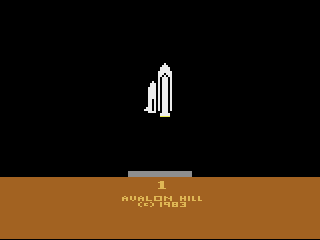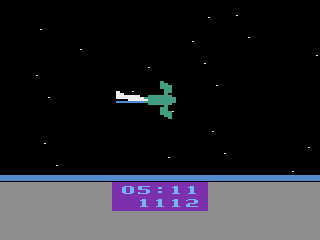Retro Replay Review
Gameplay
Shuttle Orbiter challenges players with a delicate balance of orbital mechanics and resource management. From the moment you launch your shuttle, you must monitor four colored orbit indicators—white for your shuttle, gold for the station, red for the factory, and green for the fuel depot—to ensure you stay on course. Matching your altitude and orbital position with your target is key: lower orbits yield higher speeds, while higher orbits slow you down. This simple yet demanding mechanic keeps every approach tense and requires constant adjustments.
(HEY YOU!! We hope you enjoy! We try not to run ads. So basically, this is a very expensive hobby running this site. Please consider joining us for updates, forums, and more. Network w/ us to make some cash or friends while retro gaming, and you can win some free retro games for posting. Okay, carry on 👍)
Once you draw near a station or depot, the game seamlessly transitions to a maneuvering display. Here, precise thruster bursts are used both to dock with required parts and to veer away from deadly debris. Any collision, whether with natural fragments or man-made objects, inflicts a fuel leak that drains your reserves passively and carries a 25% chance of damaging your precious cargo. The threat of permanent part loss heightens the stakes and forces players to weigh risk versus reward on every maneuver.
Shuttle Orbiter also offers four difficulty settings, selectable by moving the joystick up or down at launch. Starting at Game 0—with no debris field—players can steadily build their skills before facing the chaos of space junk in higher modes. Without a traditional score system, the game instead measures success by how swiftly and safely you can deliver all ten components to the incomplete station. This focus on time and survival delivers a pure, minimalist arcade experience that rewards mastery of its core systems.
Graphics
Shuttle Orbiter’s visuals are crisp and utilitarian, evoking the golden age of vector graphics with their clean lines and simple color palette. The four orbiting objects are represented by four colored dots, each matched by a corresponding bar in the heads-up display. This minimalist approach keeps the focus on gameplay clarity, ensuring you never lose sight of your target or your shuttle’s status.
The HUD itself is laid out along the bottom of the screen, displaying elapsed time, remaining fuel, and the altitude bars in real time. Although there are no flashy cutscenes or texture-rich backgrounds, the stark contrast between the blackness of space and the bright orbit dots is both functional and aesthetically pleasing. Every pixel serves a purpose, reinforcing the game’s simulation ethos and making the high-stakes navigation immediately readable.
When debris fields appear in higher difficulty levels, the fragments are depicted as small, fast-moving pixels. Their unpredictable trajectories underscore the danger of drifting off course, and the visual simplicity actually enhances the tension—there’s nowhere to hide from a stray piece of space junk. Overall, Shuttle Orbiter’s graphics may feel dated by modern standards, but their clarity and purpose-driven design remain highly effective.
Story
While Shuttle Orbiter doesn’t boast a cinematic narrative, its mission premise is compelling in its simplicity. A comet has passed near Earth, scattering debris into orbit and endangering an ambitious space project. Your objective is straightforward: retrieve ten vital parts from an automated factory and deliver them to a partially completed space station. Each part is crucial to completing humanity’s next leap into the cosmos.
The lack of cutscenes or voiced dialogue places the storytelling squarely in the player’s hands. Every successful docking is a small victory that advances the unspoken tale of exploration and technological triumph. Conversely, every collision and fuel leak reminds you of the ever-present dangers lurking in space. This sparse narrative framework fosters immersion by letting gameplay events carry emotional weight.
Game variations—such as the debris-free Beginner mode—serve as narrative prologue, easing newcomers into the role of shuttle pilot. As the difficulty ramps up, the story unfolds through rising stakes: the factory’s red dot becomes both a beacon of hope and a hazard zone, while the station’s gold dot represents your ultimate achievement. By the time you place the last part, you feel like you’ve completed a genuine near-Earth rescue operation, despite the minimal in-game text.
Overall Experience
Shuttle Orbiter delivers a tense, rewarding arcade experience rooted in realistic orbital physics. The core loop—launch, orbit matching, docking, and debris avoidance—is tightly crafted and immediately engaging. Every second counts, as the clock ticks and fuel reserves dwindle. This creates an addictive push to optimize every burn and cut down on errors.
The game’s minimalist presentation reinforces its pure design philosophy. There are no superfluous menus or convoluted systems—just you, your shuttle, and the dangerous arena of low Earth orbit. Difficulty settings let you tailor the experience, making Shuttle Orbiter accessible to newcomers while still providing a stern test for seasoned players seeking a high-tension challenge.
Ultimately, Shuttle Orbiter shines as a precision-based space simulator masquerading as a simple arcade game. Its combination of easy-to-grasp mechanics and deep strategic layers means each playthrough feels fresh. While it may lack a sprawling narrative or graphical bells and whistles, its focus on core gameplay and the thrill of orbital conquest will keep enthusiasts coming back for more missions among the stars.
 Retro Replay Retro Replay gaming reviews, news, emulation, geek stuff and more!
Retro Replay Retro Replay gaming reviews, news, emulation, geek stuff and more!








Reviews
There are no reviews yet.